Italian Cuisine
Osso Buco
You’ll be captivated by osso buco, a mouthwatering Italian dish that promises tender veal and rich flavors, but there’s more to its story…
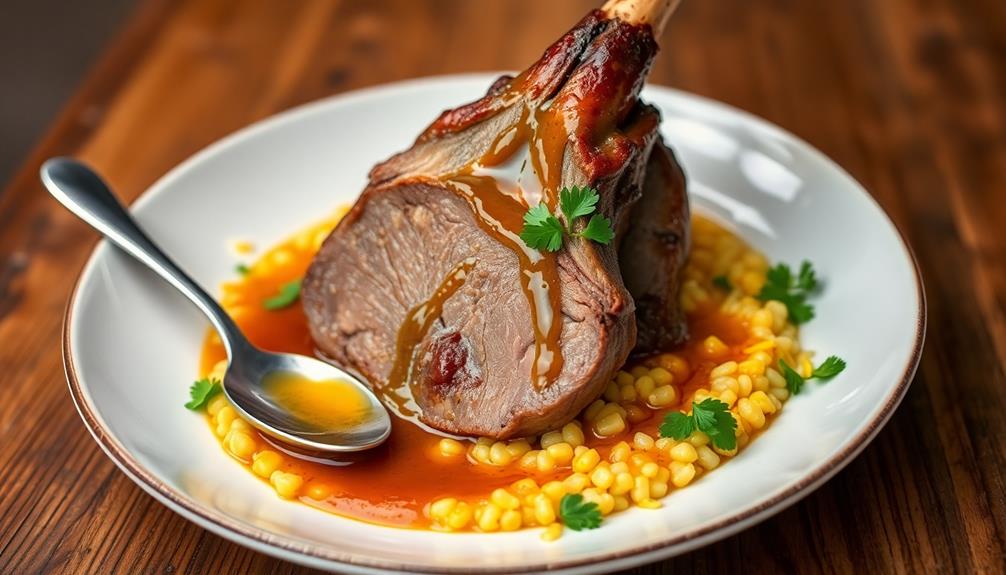
Osso buco is a delicious Italian dish that'll make your taste buds dance! It's made with tender veal shanks slow-cooked in a yummy tomato sauce. The name means "bone with a hole," which refers to the marrow inside the bone. This tasty meal started in Milan and has become a favorite for special occasions. You'll love how the meat falls off the bone and melts in your mouth. Don't forget the gremolata on top – it's a zesty mix of parsley, lemon, and garlic that adds a fresh pop of flavor. Get ready to impress your family and friends with this mouthwatering dish! There's so much more to discover about this Italian classic.
Key Takeaways
- Osso Buco is a classic Milanese dish featuring braised veal shanks in a tomato-based sauce.
- The dish's name means "bone with a hole," referring to the marrow-filled veal shank used.
- Traditionally served with gremolata (parsley, lemon zest, and garlic) and paired with risotto or polenta.
- Slow cooking is key to achieving tender meat and rich flavor in Osso Buco.
- Originally a humble meal, Osso Buco has evolved into a beloved staple of Italian cuisine.
History
Few dishes can claim the rich history of osso buco. This Italian favorite has been warming hearts and filling bellies for centuries!
You'll find its roots in the bustling city of Milan, where it first became popular in the late 19th century.
Osso buco, which means "bone with a hole" in Italian, gets its name from the marrow-filled veal shank that's the star of the show.
Back in the day, it was a humble meal for working-class families. They'd use tough cuts of meat that needed long, slow cooking to become tender and delicious.
Over time, this simple dish became a beloved staple in Italian cuisine.
Here's how it evolved:
- Originally made with just veal, onions, and wine
- Later, chefs added tomatoes and vegetables
- Gremolata (a zesty herb topping) became a popular addition
You'll often find osso buco served at festive gatherings and special occasions.
It's a dish that brings people together, just as it has for generations.
Whether you're in Milan or your own kitchen, osso buco's history is part of what makes it so special! Osso buco, a traditional Italian dish, has been enjoyed for centuries and is steeped in culinary tradition. The slow-cooked veal shanks, flavored with vegetables, white wine, and broth, create a rich and tender dish that is beloved by food lovers all over the world. And when it comes to Italian cuisine, tradition is key- from the preparation to the presentation. Just as osso buco has its roots in the northern region of Italy, so too does the traditional Italian seafood stew, creating a regional diversity of flavors and cooking techniques that contribute to the richness of Italian cuisine.
Recipe
Osso buco is a classic Milanese dish that showcases tender veal shanks braised to perfection in a rich tomato-based sauce. This hearty and comforting meal is traditionally served with a bright gremolata topping and often accompanied by risotto alla Milanese or polenta.
The key to a successful osso buco lies in the slow cooking process, which allows the tough connective tissues in the veal shanks to break down, resulting in melt-in-your-mouth meat. The marrow inside the bone adds an extra layer of richness to the sauce, making it a truly indulgent dish perfect for special occasions or cold winter nights.
- 4 veal shanks (about 1 1/2 inches thick)
- 1/2 cup all-purpose flour
- 4 tablespoons olive oil
- 1 large onion, diced
- 2 carrots, diced
- 2 celery stalks, diced
- 4 garlic cloves, minced
- 1 cup dry white wine
- 1 cup beef broth
- 1 can (14.5 oz) diced tomatoes
- 2 bay leaves
- 2 sprigs fresh thyme
- Salt and freshly ground black pepper
- For gremolata: 1/4 cup chopped fresh parsley, 1 tablespoon lemon zest, 1 garlic clove (minced)
To prepare osso buco, start by dredging the veal shanks in flour seasoned with salt and pepper. In a large Dutch oven, heat the olive oil over medium-high heat and brown the shanks on all sides. Remove the meat and set aside.
In the same pot, sauté the onion, carrots, celery, and garlic until softened. Deglaze with white wine, scraping up any browned bits. Add the beef broth, diced tomatoes, bay leaves, and thyme. Return the veal shanks to the pot, bring to a simmer, cover, and cook in a preheated 325°F (165°C) oven for about 2 hours or until the meat is tender and falling off the bone. Serve topped with gremolata.
For best results, make osso buco a day ahead and reheat before serving, as this allows the flavors to develop further. When choosing veal shanks, look for pieces that are similar in size to ensure even cooking.
If veal is unavailable or not preferred, beef shanks can be used as a substitute, though they may require a longer cooking time. Remember to tie the shanks with kitchen twine before cooking to help them maintain their shape during the long braising process.
Cooking Steps
You're about to embark on a culinary adventure with osso buco!
Let's walk through the key steps to create this mouthwatering dish. From searing the veal shanks to garnishing with zesty gremolata, you'll transform simple ingredients into a feast for the senses.
Step 1. Sear Veal Shanks Until Browned
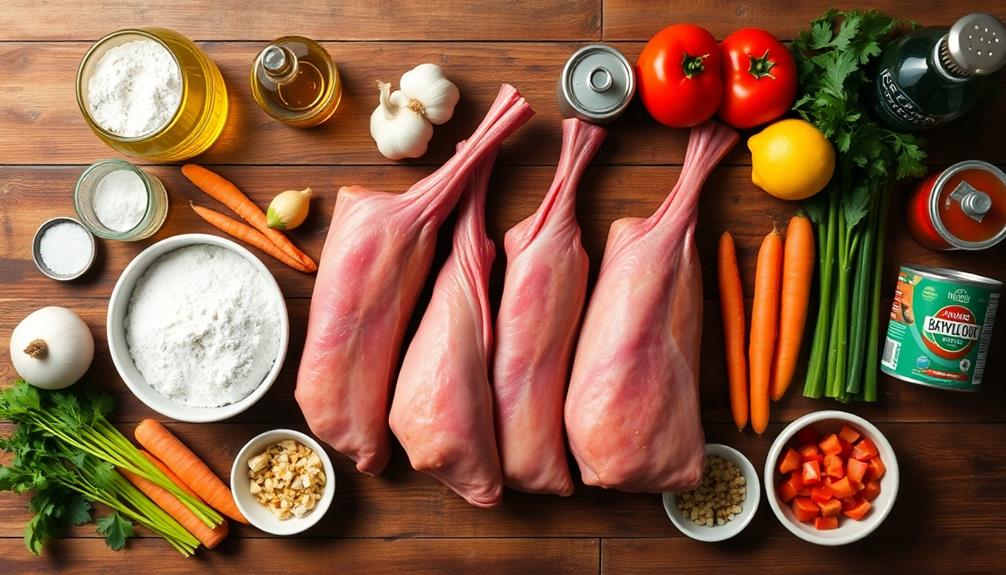
To kick off the cooking process, heat a large, heavy-bottomed pot or Dutch oven over medium-high heat. Add a splash of oil and let it get nice and hot.
While you're waiting, pat the veal shanks dry with paper towels. This helps them brown better!
Now, it's time for the fun part. Carefully place the veal shanks in the hot pot. You'll hear a satisfying sizzle as they hit the oil. Let them cook for about 3-4 minutes on each side, until they're golden brown. Don't forget to season them with salt and pepper as they cook!
Here are some tips to make sure your veal shanks brown perfectly:
- Don't overcrowd the pot. Cook in batches if needed.
- Use tongs to flip the shanks gently.
- Be patient! Good browning takes time.
Once all sides are browned, remove the shanks from the pot and set them aside. You'll notice some tasty brown bits stuck to the bottom of the pot. Don't worry, these will add amazing flavor to your dish later on!
Step 2. Sauté Vegetables and Aromatics
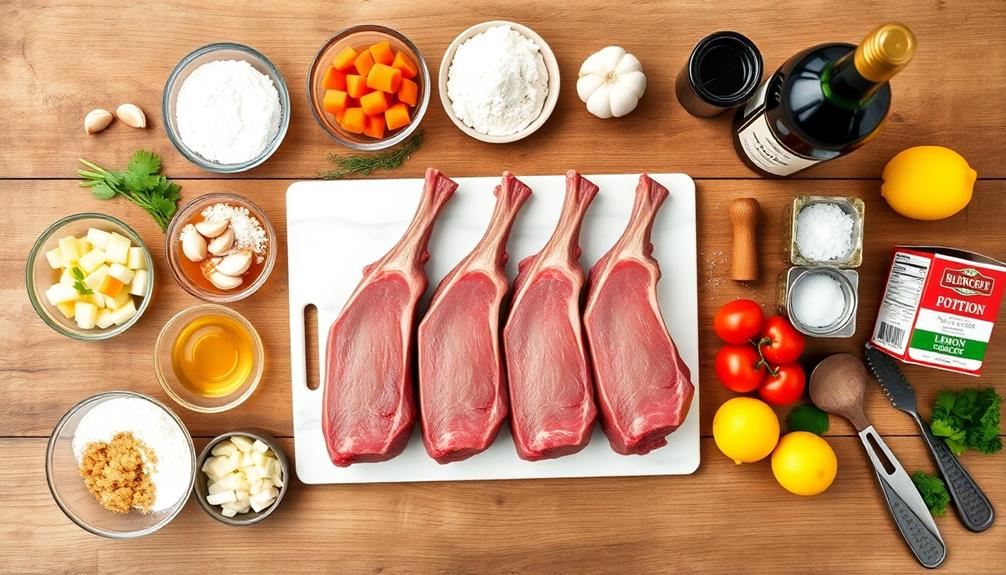
After removing the browned veal shanks, it's time to build the flavor base for your osso buco. In the same pot, you'll create a delicious mixture called soffritto. Here's what you need to do:
- Add a splash of olive oil to the pot
- Toss in finely chopped onions, carrots, and celery
- Stir the veggies until they're soft and fragrant
Now, let's add some aromatic ingredients to make your osso buco extra tasty:
- Mince some garlic cloves and add them to the pot
- Sprinkle in some fresh herbs like thyme and rosemary
- Add a bay leaf for a subtle, earthy flavor
Keep stirring everything together, and you'll soon smell the wonderful aroma filling your kitchen.
This mixture will give your osso buco a rich, savory taste that your family will love. As the vegetables cook, they'll start to caramelize, which means they'll turn slightly brown and sweet.
This process takes about 10 minutes, so be patient and keep stirring. Your taste buds will thank you later!
Step 3. Add Wine and Broth
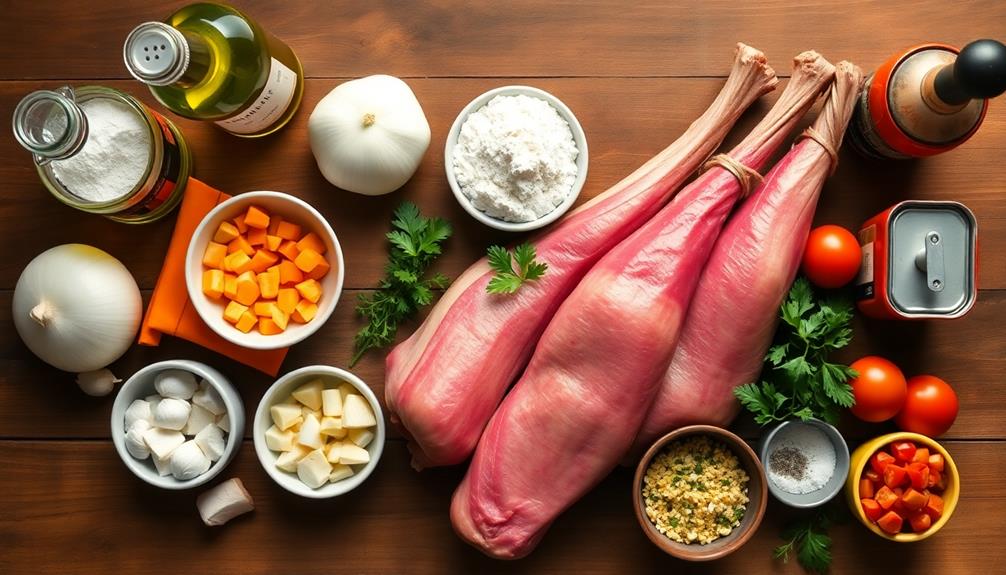
With the aromatic base ready, it's time to add liquid and build depth in your osso buco. Grab your favorite red wine and pour it into the pot. Watch as it sizzles and bubbles, filling the kitchen with a wonderful aroma. Let the wine simmer for a few minutes, allowing the alcohol to cook off and the flavors to concentrate.
Next, it's time to add the broth. You can use:
- Beef broth
- Chicken broth
- Vegetable broth
Pour in enough broth to nearly cover the meat. This liquid will help tenderize the veal shanks and create a rich, flavorful sauce.
Don't forget to add these extras for more flavor:
- A can of diced tomatoes
- A bay leaf or two
- A sprig of fresh rosemary
Give everything a gentle stir, making sure the meat is nestled in the liquid.
Now, you're ready for the next step in creating your delicious osso buco. The house will soon be filled with mouthwatering smells that'll make everyone excited for dinner!
Step 4. Braise in Oven

Once you've prepared the base and added the liquids, it's time to braise the osso buco in the oven. This is where the magic happens! Preheat your oven to 325°F (165°C). Cover the pot with a tight-fitting lid or aluminum foil to keep all the yummy flavors inside.
Carefully place the pot in the preheated oven. Now, let's talk about cooking time:
- For veal shanks: Cook for about 2 to 2.5 hours
- For beef shanks: Cook for about 3 to 3.5 hours
The meat is ready when it's super tender and almost falling off the bone. You'll know it's done when:
- You can easily pierce the meat with a fork
- The meat has shrunk away from the bone
- The marrow in the bone is soft and jiggly
During cooking, check on your osso buco every hour. If the liquid level drops too low, add a bit more broth.
When it's done, take the pot out of the oven. Let it rest for 10 minutes before serving. Your family will love this tender, flavorful dish!
Step 5. Garnish With Gremolata
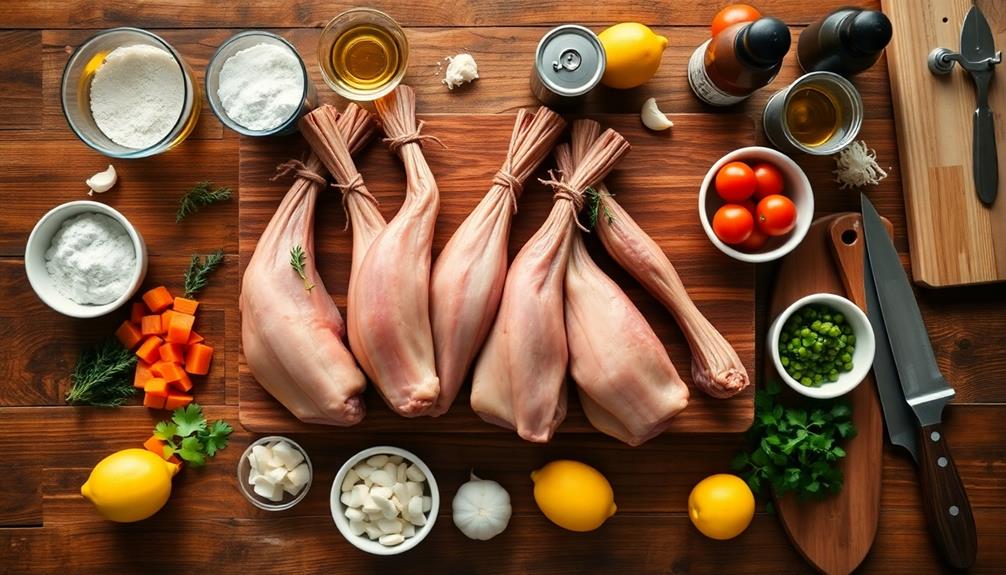
The final touch for your osso buco comes in the form of a bright, zesty gremolata. This simple garnish adds a burst of fresh flavor that'll make your dish shine. Let's make it together!
Here's what you'll need:
- 1/4 cup fresh parsley, finely chopped
- 1 lemon, zested
- 1 clove of garlic, minced
To prepare the gremolata:
- Mix all ingredients in a small bowl
- Stir well to combine
When your osso buco is ready to serve, sprinkle the gremolata on top. The fresh herbs and citrus will cut through the rich, savory flavors of the meat.
It's like adding a pop of color to a painting!
Don't worry if you have leftovers. Gremolata is versatile and tasty on many dishes. Try it on:
- Grilled fish
- Roasted vegetables
- Pasta dishes
Final Thoughts
Osso buco stands out as a culinary masterpiece that's well worth the effort to prepare. You'll find that this dish is perfect for special occasions or when you want to impress your family and friends. The tender meat, rich sauce, and bright gremolata create a wonderful balance of flavors that'll make your taste buds dance with joy!
Remember these key points when making osso buco:
- Choose high-quality veal shanks
- Brown the meat well for extra flavor
- Use a good wine for the sauce
- Cook low and slow for the best results
- Don't forget the gremolata for a fresh finish
You can serve osso buco with:
- Creamy risotto
- Soft polenta
- Mashed potatoes
- Crusty bread
Don't be afraid to try this classic Italian dish at home. With a little patience and love, you'll create a meal that'll have everyone asking for seconds.
The leftovers (if there are any) taste even better the next day, so you might want to make a big batch. Enjoy the process of cooking this delicious meal, and savor every bite with your loved ones!
Frequently Asked Questions
Can Osso Buco Be Made With Other Meats Besides Veal?
You can definitely make osso buco with other meats. While traditionally made with veal, you'll find delicious variations using beef shanks, pork shanks, or even lamb shanks. Each meat brings its own unique flavor to the dish.
How Long Does Leftover Osso Buco Stay Fresh in the Refrigerator?
You'll want to consume your leftover osso buco within 3-4 days. Store it in an airtight container in the fridge. For best quality, reheat it gently on the stovetop or in the microwave before serving.
What Are Suitable Side Dishes to Serve With Osso Buco?
You'll love pairing your dish with creamy risotto Milanese or polenta. Roasted vegetables like carrots or Brussels sprouts complement it well. Don't forget crusty bread to soak up the sauce. A fresh green salad adds balance.
Is Osso Buco Suitable for Freezing and Reheating Later?
Yes, you can freeze and reheat it later. It's actually great for meal prep! Make sure you cool it completely before freezing. When you're ready, thaw it overnight and gently reheat on the stovetop or in the oven.
Are There Any Vegetarian or Vegan Alternatives to Traditional Osso Buco?
You can make vegetarian osso buco using thick-cut portobello mushrooms or eggplant slices. Replace the veal with these alternatives and use vegetable broth instead of meat stock. You'll still get a rich, flavorful dish that's meat-free.
Luca is our resident expert in Italian cuisine, with a deep love for fresh ingredients, classic pasta dishes, and rustic pizzas. He brings the heart of Italy to Cook if Ya, sharing recipes that highlight the simplicity and elegance of traditional Italian cooking, always paired perfectly with local wines.
Italian Cuisine
Zabaglione
Forget the calories, this indulgent Italian custard, Zabaglione, is a decadent delight that will transport you to la dolce vita with just one spoonful.

Zabaglione is the stuff dreams are made of – a rich and creamy Italian dessert that's been delighting people for centuries! It's got egg yolks, sugar, and Marsala wine, which come together to create a silky, indulgent treat. You can enjoy it warm or chilled, and it pairs perfectly with biscotti, berries, or even pastries. Zabaglione is a true taste of la dolce vita, capturing the essence of Italian culture and bringing families together. If you're curious to learn more about this cherished dessert, you'll find a wealth of history, recipes, and serving suggestions in the comprehensive overview.
Key Takeaways
- Zabaglione is a traditional Italian dessert made with egg yolks, sugar, and Marsala wine or other fortified wines, known for its rich, creamy texture.
- The recipe for zabaglione dates back to the 14th century and is an integral part of Italian culture, often served at weddings and holidays.
- Zabaglione is a rich source of protein from the egg yolks, but also contains sugar and alcohol from the wine, making it a treat to be enjoyed in moderation.
- The preparation method for zabaglione involves whisking the ingredients over a double boiler to achieve a light, airy consistency.
- Zabaglione can be served on its own, or used as a filling or topping in various desserts, and can be paired with fresh fruits, biscotti, or sponge cake.
History
Zabaglione, a classic Italian dessert, has a rich and indulgent history. This frothy, custard-like treat has been delighting taste buds for centuries! Originating in Italy, the first recorded recipe dates back to the 14th century, though its roots likely stretch even further.
Over the years, zabaglione has become a beloved part of Italian culture. It's often served at special occasions, like weddings and holidays, adding a touch of elegance and decadence.
The key ingredients – egg yolks, sugar, and Marsala wine – create a luxurious, velvety texture that melts in your mouth.
Whether enjoyed on its own or paired with fresh fruit, zabaglione is a true delight. Its history reflects the Italian passion for food, family, and living life to the fullest.
Recipe
Zabaglione is a rich and creamy Italian dessert that's often enjoyed as a light and airy treat. It's a versatile dish that can be served on its own or paired with fresh fruit, sponge cake, or other desserts.
The key to a successful zabaglione is to whip the egg yolks and sugar until they're light and fluffy, and then gently fold in the Marsala wine or other fortified wine. This creates a delicate and silky texture that melts in your mouth.
Ingredients:
- 6 large egg yolks
- 1/2 cup granulated sugar
- 1/2 cup Marsala wine or other fortified wine
- 1/4 cup heavy cream (optional)
Instructions: In a large, heatproof bowl, whisk together the egg yolks and sugar until the mixture is light and fluffy, about 3-5 minutes.
Place the bowl over a saucepan of simmering water, making sure the bowl doesn't touch the water. Whisk the mixture continuously for 5-8 minutes, or until it has thickened and doubled in volume.
Remove the bowl from the heat and immediately fold in the Marsala wine. Serve the zabaglione warm, or chill it in the refrigerator for at least 2 hours before serving.
For an even richer and creamier texture, you can fold in a 1/4 cup of heavy cream after the zabaglione has cooled. This will create a luscious and indulgent dessert.
Zabaglione is best enjoyed immediately, but can be stored in the refrigerator for up to 2 days.
Cooking Steps
Whisk the egg yolks and sugar until they're light and frothy.
Then, slowly pour in the wine and continue whisking over a double boiler until the mixture thickens.
Serve this delightful zabaglione immediately, in chilled glasses, for a truly special treat.
Step 1. Whisk Egg Yolks and Sugar
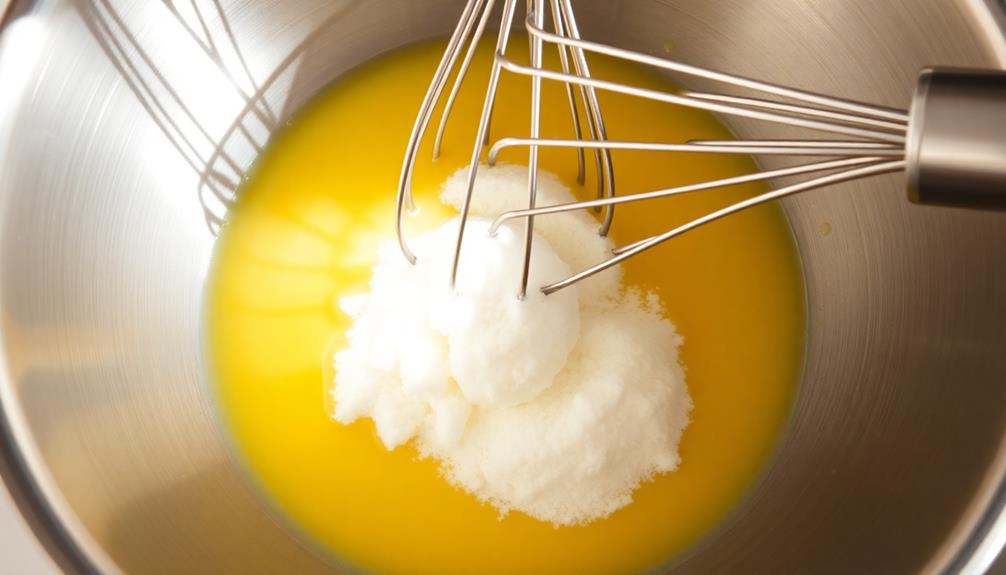
To begin the process, whisk the egg yolks and sugar together in a heatproof bowl until the mixture becomes thick and creamy. This takes just a few minutes, so be patient and keep whisking with vigor! The goal is to aerate the mixture, creating a light and fluffy texture.
Next, gently pour in the Marsala wine or sherry, whisking continuously to fully incorporate it. Don't be afraid to put some muscle into it – the more air you can work into the eggs, the better!
Once the liquid is blended in, you're ready for the next step. Place the bowl over a simmering pot of water, making sure the bottom doesn't touch the water.
Continue whisking the zabaglione steadily until it thickens to a custard-like consistency. This should take around 5-8 minutes. Keep an eye on it, as you don't want the eggs to curdle.
Once it's reached the perfect texture, remove from heat and serve immediately while warm and frothy.
Step 2. Add Wine
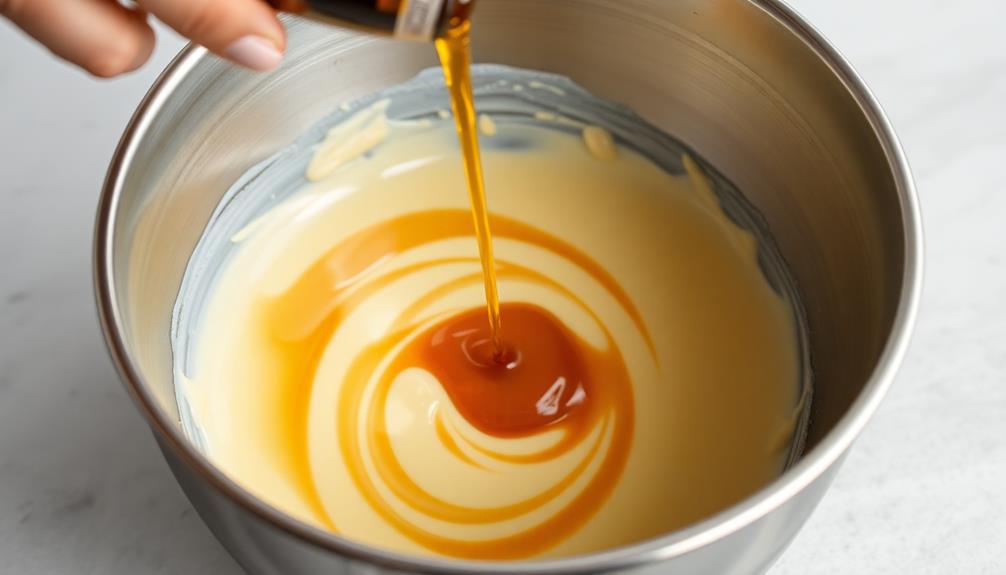
Next, gently pour in the Marsala wine or sherry, whisking continuously to fully incorporate it. The wine will give the zabaglione a delightful, rich flavor.
As you whisk, you'll notice the mixture start to thicken and become frothy. This is a crucial step, as the wine is what transforms the simple egg yolk and sugar into the signature zabaglione consistency.
Keep whisking vigorously, making sure to reach all the edges of the bowl. The wine should blend seamlessly into the egg mixture, creating a smooth, silky texture.
Don't be afraid to put some muscle into it – the more air you incorporate, the lighter and fluffier your zabaglione will be.
Once the wine is fully incorporated, your zabaglione is well on its way to perfection.
Pause for a moment to admire the gorgeous golden hue and irresistible aroma – you're one step closer to enjoying this delightful Italian dessert.
Step 3. Cook Over Double Boiler

With the wine now beautifully blended into the egg mixture, it's time to start cooking the zabaglione over a double boiler. This special cooking method helps to gently heat the ingredients without overcooking them.
First, fill the bottom pan of the double boiler with about an inch of water. Bring it to a gentle simmer over medium heat. Then, place the top pan containing the egg-wine mixture directly over the simmering water. Be sure the bottom of the top pan doesn't touch the water.
Now, start whisking the mixture continuously. As it heats, it will gradually thicken and become light and frothy. This takes about 5-8 minutes of constant whisking. Keep a close eye and don't let the mixture boil or it will curdle.
Once the zabaglione has reached the desired thick, creamy consistency, remove it from the heat. It's now ready to serve warm in dessert cups or use in other recipes. Enjoy this delightful, velvety Italian treat!
Step 4. Whisk Until Light and Frothy

Continuous whisking is key to transforming the egg-wine mixture into the desired light, airy zabaglione. Don't let your arm get tired! Keep that whisk moving in quick, circular motions for several minutes.
You'll notice the mixture start to thicken and become light and frothy as you whisk. That's exactly what you want.
Patience is crucial here – don't stop whisking too soon, or your zabaglione won't have that lovely, pillowy texture. Whisk until the mixture is pale and has tripled in volume.
You should see ribbons forming as you lift the whisk. This means the eggs have been thoroughly aerated, trapping tiny air bubbles that will make your zabaglione light and fluffy.
Once you've reached that perfect, light and frothy consistency, your zabaglione is ready to serve. Spoon it into dessert bowls and enjoy its sweet, creamy deliciousness.
This classic Italian treat is sure to delight everyone at the table.
Step 5. Serve Immediately, in Chilled Glasses

Once the zabaglione has reached the desired light, frothy texture, waste no time and quickly transfer it to chilled glasses or bowls.
You'll want to serve this luscious, golden-hued treat immediately, as its delicate, airy quality is best savored when fresh.
Carefully pour or spoon the zabaglione into your prepared vessels, filling them about three-quarters full. The cool temperature of the glasses will help to set the custard and prevent it from deflating too quickly.
For an extra special touch, consider garnishing the zabaglione with a sprinkle of cinnamon, a drizzle of sweet dessert wine, or a few fresh berries.
These simple additions can elevate the dish, making it truly shine as the star of any meal or celebration.
Serve the zabaglione right away, encouraging your family and guests to indulge in this decadent, cloud-like delight.
Its fleeting nature is part of the charm, so be sure to savor every spoonful while it's at its peak.
Final Thoughts
Zabaglione, the delicate and indulgent Italian custard, has undoubtedly left an indelible mark on the culinary world. It is often enjoyed on its own, but it also pairs beautifully with fresh fruit or Italian sweet bread. The luxurious texture and rich flavor of zabaglione make it a popular choice for elegant desserts, and it has become a staple in many Italian households. Whether served as a simple, yet decadent, ending to a meal or used as a filling for pastries, this classic custard continues to delight taste buds around the globe.
Whether you've savored it in a chilled glass or incorporated it into decadent desserts, this versatile treat has a way of capturing the hearts and taste buds of all who experience it.
As you bid farewell to this delightful exploration, remember that the true essence of zabaglione lies in its ability to bring people together.
Imagine serving this silky custard at your next family gathering or dinner party – the oohs and aahs of your guests as they indulge in its rich, velvety goodness will be music to your ears.
And who knows, you might even inspire someone to embark on their own zabaglione journey, passing down this cherished tradition to future generations.
Frequently Asked Questions
What Is the Difference Between Zabaglione and Sabayon?
Zabaglione and sabayon are the same thing – it's a light, frothy Italian custard made from egg yolks, sugar, and wine. The only difference is that "zabaglione" is the Italian term, while "sabayon" is the French version.
Can I Make Zabaglione Without Egg Yolks?
Can you make zabaglione without egg yolks? Well, no, that wouldn't be zabaglione. The key ingredient in zabaglione is egg yolks, which give it a rich, creamy texture. Without the yolks, it just wouldn't be the same.
How Long Can I Store Homemade Zabaglione?
How long can you store homemade zabaglione? The delicate custard-like dessert is best enjoyed fresh, but it can be refrigerated for up to 3 days. However, the texture and flavor may diminish over time.
Can I Use Zabaglione as a Filling for Pastries?
You can certainly use zabaglione as a filling for pastries. Its creamy, custard-like texture makes it an excellent choice for tarts, éclairs, or even layered cakes. Just be sure to chill it well before using.
Is Zabaglione Gluten-Free?
Yes, zabaglione is gluten-free. It's a light, frothy Italian custard made with just egg yolks, sugar, and Marsala wine or other fortified wine. Since it doesn't contain any wheat flour, zabaglione is a perfect gluten-free option for fillings and desserts.
Luca is our resident expert in Italian cuisine, with a deep love for fresh ingredients, classic pasta dishes, and rustic pizzas. He brings the heart of Italy to Cook if Ya, sharing recipes that highlight the simplicity and elegance of traditional Italian cooking, always paired perfectly with local wines.
Italian Cuisine
Agnolotti
Prepare to indulge in the delightful Italian pasta parcels known as agnolotti, a cherished tradition that continues to captivate culinary enthusiasts worldwide.

Agnolotti, the delightful Italian pasta parcels, have captivated culinary enthusiasts for centuries. These half-moon shaped delights originated in the Piedmont region, evolving over time to reflect unique regional flavors. Crafting agnolotti is a labor of love, as you'll prepare fresh pasta dough and flavorful fillings. Whether you choose traditional ingredients like meat and cheese or get creative with seasonal produce, the result is a satisfying and joyful dish. Pair your agnolotti with vibrant sauces or let the pasta shine on its own. This cherished Italian tradition continues to inspire home cooks and chefs alike – there's more to discover about this beloved pasta!
Key Takeaways
- Agnolotti is an Italian pasta variety typically stuffed with a range of fillings, such as cheese, meat, or vegetables, and characterized by its distinctive half-moon shape.
- The origins of agnolotti can be traced back to the 14th century in the Piedmont region of Italy, reflecting the country's rich culinary heritage.
- Preparing agnolotti is considered a labor of love, requiring the crafting of fresh pasta dough and the careful assembly of the delicate pasta pockets.
- Agnolotti is often served in broth or with various sauces, such as light, vibrant sauces or creamy sauces, to complement the delicate flavors of the dish.
- Agnolotti is celebrated as a cherished Italian pasta that brings comfort, satisfaction, and joy, and is commonly enjoyed during family gatherings and special occasions.
History
Agnolotti, a beloved pasta variety, has a rich history dating back to the 14th century in the Piedmont region of Italy. This cherished delicacy was first created by ingenious Italian chefs, who skillfully folded and filled delicate pasta dough with savory fillings.
Over the centuries, the recipe has been passed down, evolving to reflect the unique flavors of the Piedmont region. Today, agnolotti is celebrated as a true taste of Italian heritage, prepared with care and pride.
Whether filled with meat, cheese, or vegetables, each bite is a delightful explosion of flavors. Families gather around the table, sharing stories and laughter as they savor this beloved pasta.
The history of agnolotti is a testament to the enduring culinary traditions of Italy, inspiring home cooks and professional chefs alike to preserve this age-old delicacy for generations to come.
Recipe
Agnolotti is a type of Italian pasta that originated in the Piedmont region. These small, half-moon shaped ravioli are typically filled with a mixture of meat, cheese, or vegetables, and served with a variety of sauces.
To make homemade agnolotti, you'll need to prepare a pasta dough and a flavorful filling. While the process may seem daunting, the end result is well worth the effort, as the delicate texture and rich flavors of this dish are sure to impress your guests.
Ingredients:
- 2 cups all-purpose flour
- 3 large eggs
- 1 teaspoon salt
- 1 lb ground beef
- 1 onion, finely chopped
- 2 cloves garlic, minced
- 1 cup ricotta cheese
- 1/2 cup grated Parmesan cheese
- 2 tablespoons chopped fresh parsley
- Salt and pepper to taste
Cooking Instructions:
In a large bowl, combine the flour, eggs, and salt. Knead the dough until it becomes smooth and elastic. Cover and let it rest for 30 minutes.
In a skillet, cook the ground beef, onion, and garlic until the beef is browned and the onion is translucent. Drain any excess fat, then transfer the mixture to a bowl. Add the ricotta, Parmesan, and parsley, and mix well. Season with salt and pepper.
Divide the pasta dough into two equal pieces. On a lightly floured surface, roll out each piece into a thin sheet. Place tablespoons of the filling mixture onto one sheet, leaving space between each mound. Brush the exposed dough with water, then place the second sheet of dough on top and press around the filling to seal. Use a ravioli cutter or a sharp knife to cut the agnolotti into individual pieces.
When serving, you can dress the agnolotti with a variety of sauces, such as a simple butter and sage sauce, a tomato-based sauce, or a creamy mushroom sauce. The versatility of this dish makes it a perfect choice for a special occasion or a cozy family dinner.
Cooking Steps
Making homemade agnolotti is a delightful experience.
First, you'll craft the pasta dough, then roll it out into thin sheets.
Next, you'll fill those sheets with a tasty mixture before crimping and sealing the pasta.
Step 1. Make Pasta Dough
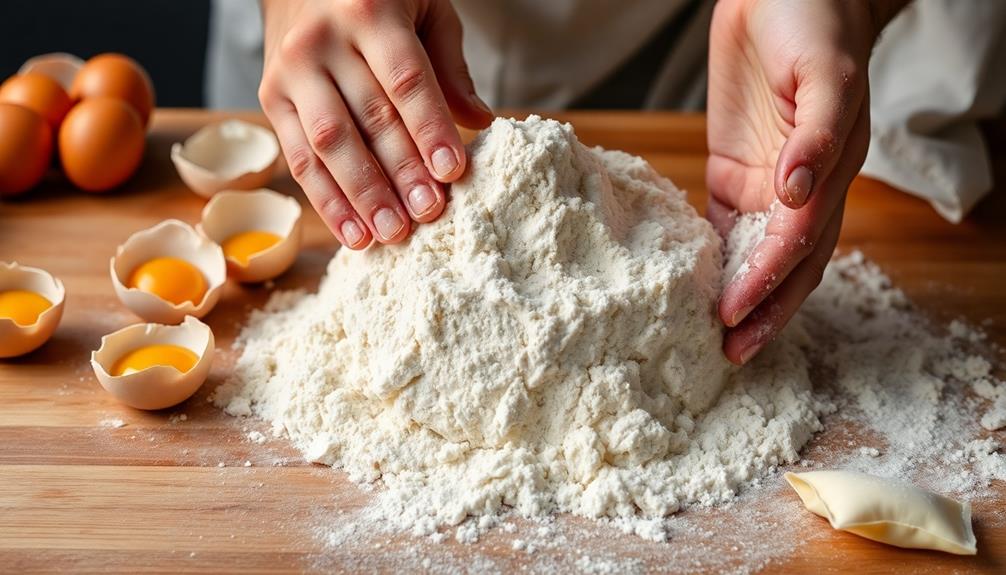
To begin the process of making pasta dough, you'll need a few key ingredients and tools. First, gather all-purpose flour, eggs, and a pinch of salt. You'll also need a clean, flat surface for kneading and a rolling pin to shape the dough.
Start by pouring the flour onto your work surface, creating a well in the middle. Crack the eggs into the well and add the salt. Using a fork, gently incorporate the eggs into the flour, slowly bringing in more flour from the sides.
Once the dough starts to come together, use your hands to knead it for about 5 minutes, until it becomes smooth and elastic.
Next, cover the dough with a clean towel and let it rest for 30 minutes. This allows the gluten to develop, making the dough easier to roll out.
When ready, use the rolling pin to flatten the dough into thin, even sheets, perfect for shaping into delicious agnolotti.
Step 2. Roll Out Pasta Sheets

With a well-rested and supple dough, you can now begin the process of rolling it out into thin, even sheets. Dust your work surface lightly with flour to prevent sticking.
Divide the dough into manageable portions, keeping the rest covered to prevent drying. Using a rolling pin, begin rolling the dough, applying even pressure and rotating it frequently. Roll the dough as thinly as possible, aiming for paper-thin sheets. Periodically, lift the dough to ensure it's not sticking, and add more flour as needed.
Once the dough is rolled out, use a sharp knife or pizza cutter to trim the edges, creating clean, rectangular sheets. Stack the sheets, separating them with a light dusting of flour to prevent them from sticking together.
With your thin, uniform pasta sheets ready, you can now move on to shaping the agnolotti, the delicious pasta pockets that will soon grace your table.
Step 3. Fill Pasta Sheets
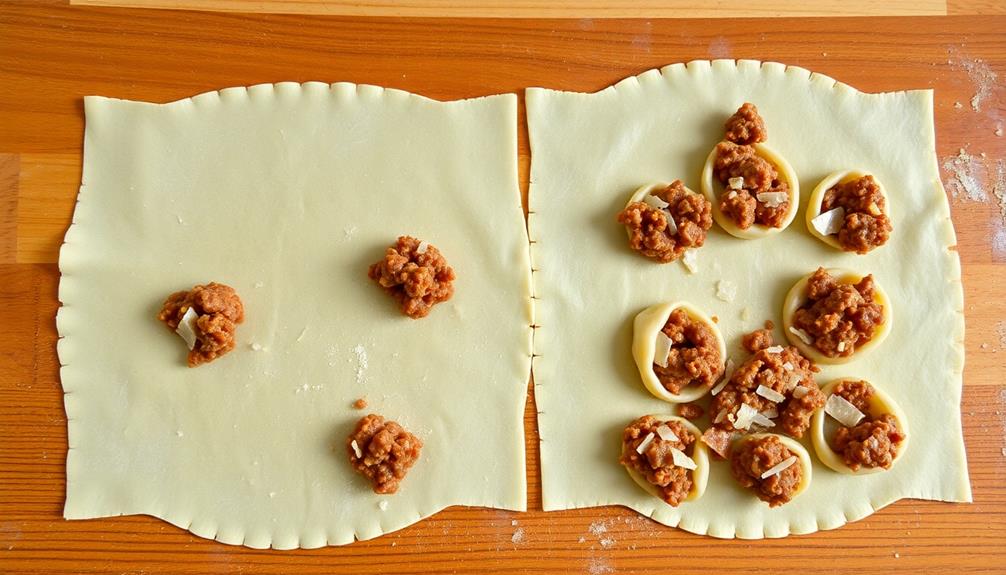
Once your pasta sheets are ready, you can begin to fill them with the desired ingredients. This is where the fun really starts! Gather your fillings – perhaps a savory blend of cheeses, fresh herbs, or even a hearty meat mixture.
Scoop small portions of the filling onto the pasta sheets, leaving a bit of space around the edges. Be careful not to overfill, as you'll need to seal the agnolotti later.
Gently fold the pasta sheets over the fillings, creating a half-moon shape. Use your fingers to firmly press and seal the edges, ensuring a tight seal. This will help the agnolotti hold their shape during cooking.
Cutting the filled pasta into individual pieces is the next step. Use a sharp knife or pastry cutter to slice the sealed pasta into your desired size and shape.
Voila! Your agnolotti are now ready to be cooked and enjoyed.
Step 4. Crimp and Seal Filled Pasta

After you've neatly arranged the filled pasta sheets, it's time to crimp and seal them. Grab your crimping tool and get ready to work!
Gently place one filled pasta sheet on the tool, making sure the filling is evenly distributed. Then, press down firmly to create those signature crimped edges. Repeat this process for each of your pasta sheets, being careful not to overstuff them.
Once all your pasta is crimped, it's time to seal them up. Dip your fingers in a bit of water and lightly moisten the edges of the pasta. This will help the layers stick together and create a tight seal.
Gently fold the pasta in half, pressing the edges firmly to secure them. Voila! Your delicious agnolotti are now ready to be cooked and enjoyed.
Step 5. Cook in Boiling Water
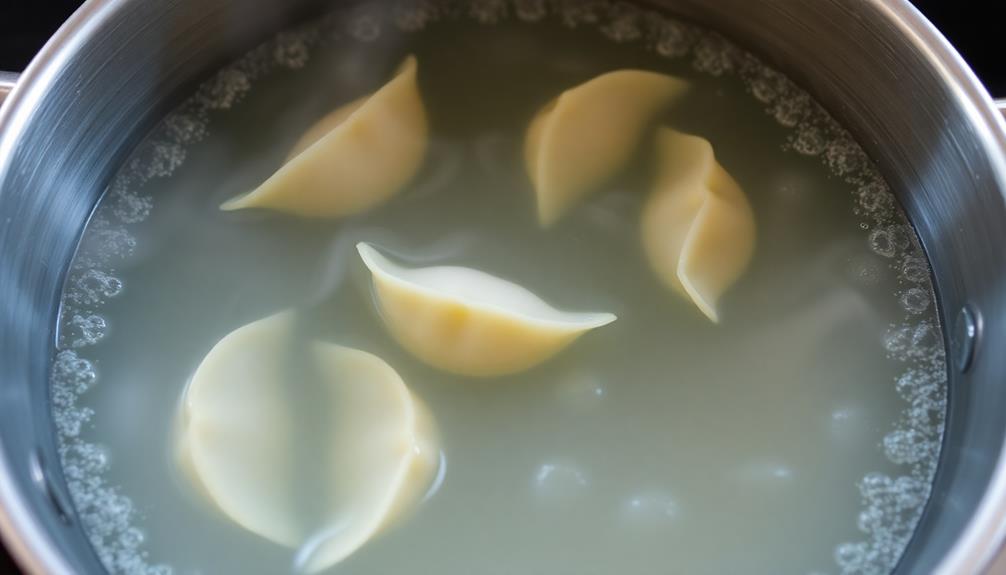
Bring a large pot of salted water to a rolling boil. Once it's bubbling vigorously, gently drop in those precious agnolotti.
Don't worry – they'll float to the top when they're done! Let them dance in the hot water for just 2-3 minutes. You'll know they're ready when they're tender and pillowy.
Drain the agnolotti carefully, then return them to the pot. Toss them with your favorite sauce – maybe a simple garlic-butter or a bright, herby pesto.
The pasta will soak up all those delectable flavors. Sprinkle with freshly grated Parmesan for the perfect finishing touch. Mmm, doesn't that sound divine?
Serve the agnolotti immediately, while they're hot and at their best. This quick-cooking filled pasta is the ultimate in comfort and convenience.
Your family will love digging into these little flavor-packed pockets. Buon appetito!
Final Thoughts
Agnolotti, a cherished Italian pasta, is a delightful culinary exploration that transcends the boundaries of simplicity. Whether you're hosting a family gathering or indulging in a solo meal, these delicate parcels of flavor will leave you with a smile and a satisfied palate. The traditional filling of agnolotti is a savory blend of meat, cheese, or vegetables, enveloped in a thin layer of pasta dough. These potatobased dumplings add a layer of richness and heartiness to the dish, making it a favorite comfort food in Italian cuisine. Whether served with a light butter and sage sauce or a hearty meat ragu, agnolotti are sure to delight your taste buds and leave you craving for more.
Crafting the perfect agnolotti is a labor of love, but the rewards are immeasurable. The dance between the dough, the filling, and the sauce is a symphony of textures and tastes that will delight your senses.
Serve them with a light, vibrant sauce that complements the delicate flavors, or let them shine on their own with a drizzle of high-quality olive oil.
As you savor each bite, remember that the true essence of agnolotti lies not only in its taste but also in the joy of sharing it with loved ones.
Embrace the tradition, experiment with new fillings, and let the flavors transport you to the heart of Italian culinary excellence.
Frequently Asked Questions
How Long Can Fresh Agnolotti Be Stored?
Fresh pasta, like agnolotti, can be stored in the refrigerator for 3-5 days. Keep it in an airtight container and use it within this timeframe for the best texture and flavor. Freezing can extend its shelf life even further.
Can Agnolotti Be Frozen and Reheated?
Yes, you can freeze and reheat agnolotti. Freeze the uncooked pasta for up to 3 months. When ready to eat, simply boil or sauté the frozen agnolotti until heated through, then serve with your favorite sauce.
What Is the Best Way to Reheat Leftover Agnolotti?
The best way to reheat leftover agnolotti is to gently simmer them in a skillet with a bit of broth or sauce. This will help them retain their texture and flavor without drying them out.
Can Vegetarian Fillings Be Used in Agnolotti?
You can definitely use vegetarian fillings in agnolotti. The pasta itself is just a shell, so you can get creative with the stuffing. Try fillings like roasted vegetables, mushrooms, or even a plant-based cheese for a delicious meatless option.
Are There Any Gluten-Free Options for Agnolotti?
Yes, there are gluten-free options for this traditional Italian pasta. You can make agnolotti with gluten-free flour blends or opt for fillings that don't contain gluten, allowing you to enjoy this dish even with dietary restrictions.
Luca is our resident expert in Italian cuisine, with a deep love for fresh ingredients, classic pasta dishes, and rustic pizzas. He brings the heart of Italy to Cook if Ya, sharing recipes that highlight the simplicity and elegance of traditional Italian cooking, always paired perfectly with local wines.
Italian Cuisine
Pasta With Tomato Sauce
Flavorful and comforting, this classic Italian dish featuring pasta tossed in a rich tomato sauce is a beloved family favorite that dates back centuries. Read on to discover more.

Pasta with tomato sauce is a timeless classic that brings families together! This beloved Italian dish has origins dating back to the 16th century, when tomatoes were first introduced to Europe. Today, you can find unique regional variations across Italy, from rustic southern sauces to complex northern styles. To make it, you'll simmer onions, garlic, and crushed tomatoes until thick and flavorful. Toss the sauce with your favorite pasta, then top with fragrant basil and nutty Parmesan for the perfect bite. It's a comforting, customizable meal that's sure to become a new family favorite. And if you keep reading, you'll discover even more about this classic dish. Looking for a delicious twist on the classic pasta with tomato sauce? Try experimenting with a spaghetti carbonara recipe. This creamy dish hailing from Rome features pancetta, eggs, and plenty of cheese for a decadent and satisfying meal. With so many variations to explore, it’s no wonder pasta with tomato sauce remains a beloved staple in homes and restaurants around the world.
Key Takeaways
- Pasta with tomato sauce is a classic Italian dish with origins dating back to the 16th century when tomatoes were introduced to Europe.
- Regional variations of tomato sauce have developed across Italy, ranging from rustic southern styles to more complex northern varieties.
- The dish is versatile, allowing for customization based on personal taste preferences, and emphasizes the quality of ingredients.
- Proper cooking techniques, such as simmering the sauce and achieving al dente pasta, are crucial for the dish's overall success.
- Pasta with tomato sauce is often enjoyed in shared settings, creating opportunities for bonding and fostering a sense of community and togetherness.
History
The origins of pasta with tomato sauce can be traced back to the 16th century, when tomatoes were first introduced to Europe from the Americas.
These juicy, colorful fruits quickly became a staple ingredient in Italian cuisine, and enterprising cooks started experimenting with pairing them with the popular pasta dishes of the time.
Over the centuries, this classic combination evolved, with different regions of Italy developing their own unique styles of tomato sauce.
From the simple, rustic sauces of the south to the more complex, seasoned varieties of the north, each version celebrates the natural sweetness and acidity of the tomato, perfectly complementing the hearty texture of the pasta.
Today, pasta with tomato sauce, or "pasta al pomodoro," remains a beloved dish, enjoyed by families around the world.
Whether served as a cozy weeknight meal or a centerpiece of a lively celebration, this timeless recipe continues to bring people together, one delicious bite at a time.
Recipe
Pasta with Tomato Sauce
Recipe
Pasta is a beloved staple in many households, and one of the most classic and comforting dishes is pasta with tomato sauce. This simple yet delicious meal is easy to prepare and can be customized to suit your taste preferences. Whether you're a seasoned home cook or a newbie in the kitchen, this recipe will guide you through the steps to create a delectable pasta dish that will impress your friends and family.
Tomato sauce is the foundation of this recipe, and the key to achieving the perfect flavor lies in the quality of the ingredients and the care taken during the cooking process. By simmering the sauce gently and allowing the flavors to meld, you'll end up with a rich, flavorful topping that complements the pasta perfectly.
Ingredients:
- 1 lb (500g) of your favorite pasta (e.g., spaghetti, penne, or rigatoni)
- 1 tablespoon olive oil
- 1 onion, diced
- 3 cloves of garlic, minced
- 1 (28 oz/800g) can of crushed tomatoes
- 1 teaspoon dried oregano
- 1/2 teaspoon dried basil
- Salt and pepper to taste
- Grated Parmesan cheese (optional)
Instructions:
In a large pot, bring salted water to a boil. Add the pasta and cook according to the package instructions until al dente. Drain the pasta and set it aside.
In a saucepan, heat the olive oil over medium heat. Add the diced onion and sauté until translucent, about 5 minutes. Stir in the minced garlic and cook for 1 minute, until fragrant.
Pour in the can of crushed tomatoes and add the dried oregano and basil. Season with salt and pepper to taste. Simmer the sauce for 15-20 minutes, stirring occasionally, until it has thickened.
Toss the cooked pasta with the tomato sauce, ensuring the pasta is evenly coated. Serve hot, topped with grated Parmesan cheese if desired.
For best results, use high-quality canned crushed tomatoes and fresh herbs if available. The longer the sauce simmers, the more the flavors will develop, so feel free to let it simmer for a bit longer if time permits. Enjoy your homemade pasta with tomato sauce!
Cooking Steps
Dice the onions and sauté them in olive oil until they're soft.
Next, add the crushed garlic and let it cook for a minute.
Then, toss in the chopped tomatoes and let the mixture simmer until the tomatoes break down into a delicious sauce.
Step 1. Dice Onions, Sauté in Olive Oil
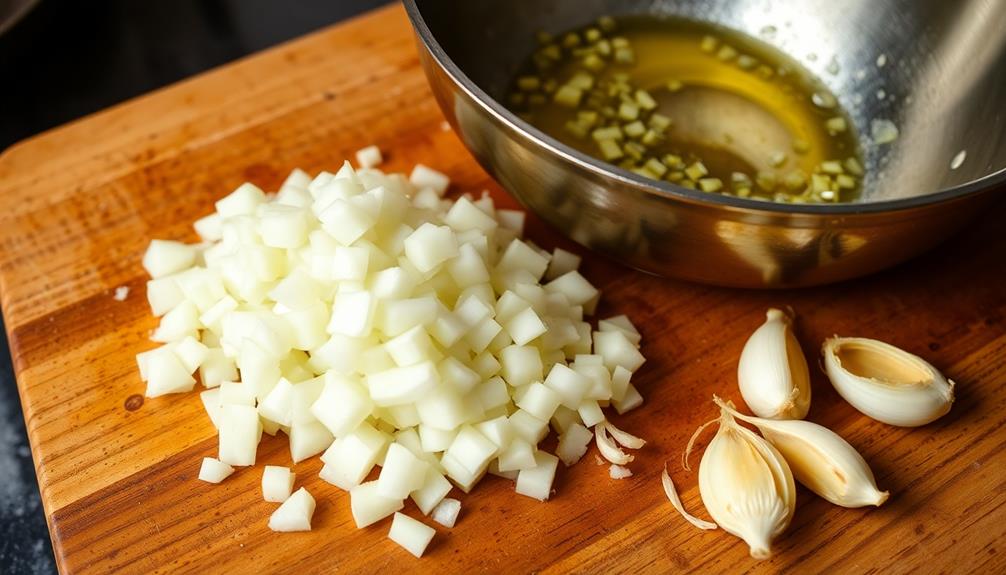
Dicing the onions and sautéing them in olive oil is the next crucial step in this recipe. Don't be intimidated – it's easy!
First, grab a sharp knife and a sturdy cutting board. Carefully slice the onion in half from root to stem, then thinly slice each half. Next, stack the slices and cut them crosswise into small, evenly-sized pieces. This is called dicing.
Now, let's get cooking! Heat a couple tablespoons of olive oil in a pan over medium heat. Once the oil is shimmering, add the diced onions.
Sauté the onions, stirring occasionally, until they're soft and translucent, about 5-7 minutes. Be sure to keep an eye on them so they don't burn. The onions should have a lovely golden color when they're ready.
Sautéing the onions brings out their natural sweetness and infuses the oil with their savory flavor – it's an essential foundation for the tomato sauce.
Get ready, because the aroma is about to fill your kitchen!
Step 2. Add Crushed Garlic
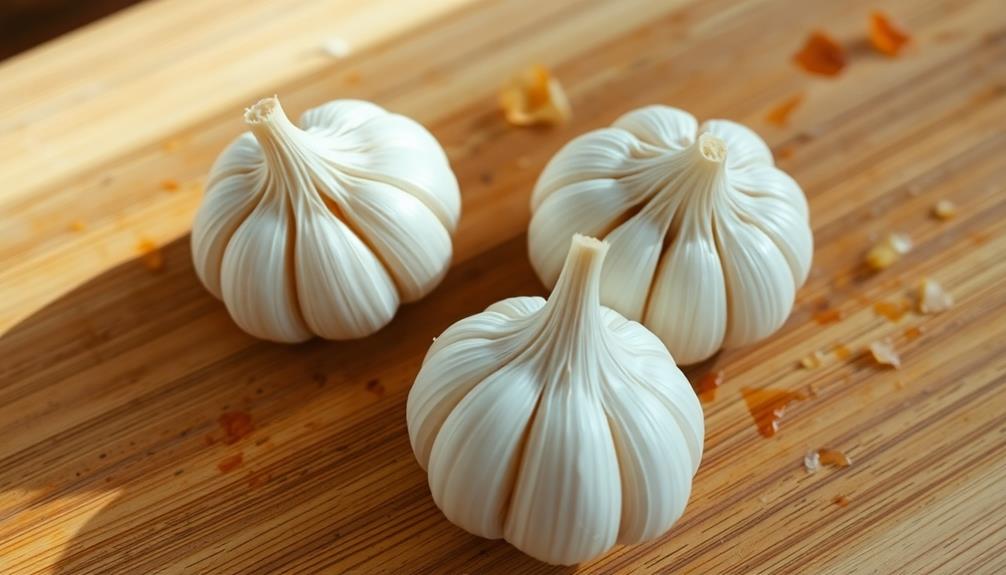
With the aromatic onions sizzling away, it's time to add the next layer of flavor – crushed garlic.
Grab a couple of fresh garlic cloves and give them a good smash with the flat side of your knife. This'll release the garlic's tasty oils and get that mouthwatering aroma going.
Toss the crushed garlic into the pan with the onions and let it sizzle for a minute or two. Stir it around so the garlic doesn't burn – you just want it to get nice and fragrant.
The garlic will add a lovely savory depth to your tomato sauce, making every bite even more delicious. Remember, a little garlic goes a long way, so don't overdo it. Just a couple of cloves should do the trick!
Once the garlic's had a chance to work its magic, you're ready to move on to the next step. Get ready for some tomatoey goodness!
Step 3. Add Chopped Tomatoes

Next, grab a can of diced tomatoes or some fresh, ripe tomatoes and give them a rough chop. You want those juicy tomatoes to be in bite-sized pieces, ready to soak up all the flavors. Toss the chopped tomatoes into the sizzling garlic. Mmm, can you already smell that mouthwatering aroma?
Now, let's give those tomatoes a minute or two to cook down. As they simmer, they'll release their natural sweetness, creating a rich, velvety sauce. Stir the mixture occasionally, ensuring the garlic doesn't burn. You want everything to meld together into a harmonious blend of flavors.
Once the tomatoes have softened and the sauce has thickened slightly, it's time to adjust the seasoning. Give it a taste and add a pinch of salt and pepper to balance the flavors.
Step 4. Simmer Until Tomatoes Break Down

After tossing the chopped tomatoes into the sizzling garlic, let them simmer for a minute or two.
You'll see the tomatoes start to break down and release their juices, creating a lovely, rich sauce. Stir the mixture occasionally to ensure even cooking.
As the tomatoes soften, you can use the back of a wooden spoon to gently mash them against the side of the pan. This will help thicken the sauce and release even more of their natural sweetness.
Breathe in the heavenly aroma of the simmering sauce – it's sure to get your taste buds tingling!
Keep an eye on the pan, and when the tomatoes have completely broken down and the sauce has thickened to your desired consistency, it's time to move on to the next step.
Buon appetito!
Step 5. Add Fresh Basil Leaves
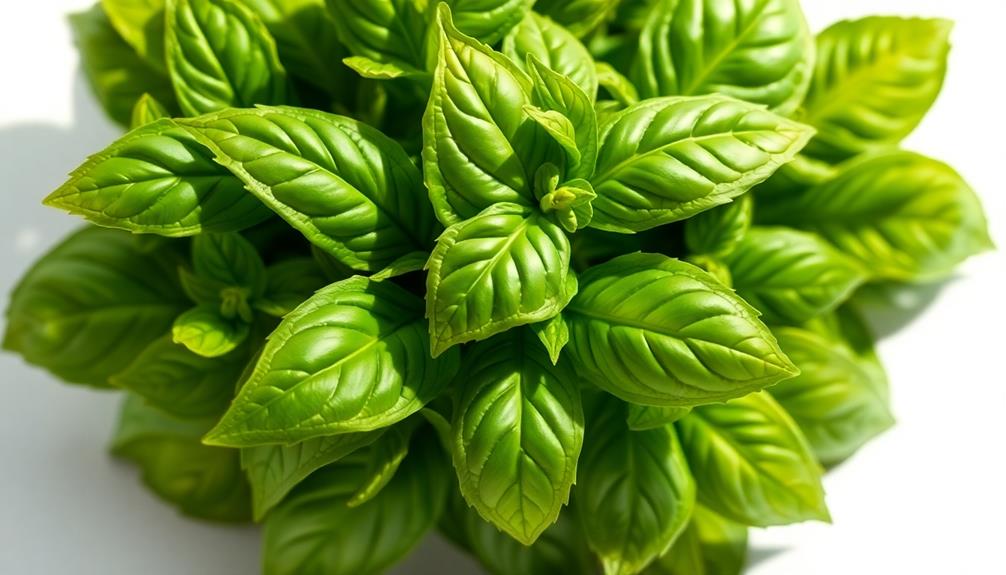
Towards the end of simmering, tear or chop the fresh basil leaves and stir them into the thickened tomato sauce. The fragrant, green leaves will instantly infuse the dish with an aromatic, herbal essence.
As the basil wilts and combines with the rich tomato flavor, it creates a mouthwatering, authentic Italian taste.
Be sure to tear or chop the basil just before adding it to the sauce. This will help the essential oils release, heightening the fresh, peppery notes.
Gently fold the basil into the sauce, allowing it to wilt and blend seamlessly. The vibrant green flecks will beautifully contrast the deep red of the tomatoes, making for a visually stunning presentation.
The final touch of fresh basil ties all the flavors together, elevating the simple tomato sauce into a truly memorable pasta dish. Your family is sure to savor every bite, transported to the Italian countryside with each flavorful forkful.
Final Thoughts
Pasta with tomato sauce is a classic dish that never fails to satisfy. Whether you're whipping it up for a family dinner or hosting a lively gathering, this beloved recipe is sure to bring smiles all around.
The final touches are what really make it shine. Don't forget to sprinkle on some fresh basil leaves – their vibrant green hues and aromatic flavor will transport you straight to an Italian trattoria.
And let's not overlook the importance of a sprinkle of Parmesan cheese. Its salty, nutty notes complement the rich tomato sauce perfectly.
As you twirl your fork through the perfectly al dente pasta, savor each delicious bite. This comforting, crowd-pleasing dish is a true celebration of simple, quality ingredients.
Enjoy it with your loved ones, and create memories that will last long after the last morsel is devoured.
Frequently Asked Questions
What Type of Pasta Is Best for Pasta Al Pomodoro?
For a classic pasta al pomodoro, you'll want to choose a short, sturdy pasta shape like penne, rigatoni, or fusilli. These will hold the tomato sauce well and provide a satisfying texture in every bite.
Can I Use Canned Tomatoes Instead of Fresh?
Sure, you can use canned tomatoes instead of fresh for your dish. Canned tomatoes are a convenient and versatile option that can provide the same great flavor as fresh. Just be sure to choose high-quality canned tomatoes for the best results.
How Do I Prevent the Sauce From Becoming Too Watery?
To prevent your sauce from becoming too watery, you can try simmering it for longer, using less liquid, or adding a thickener like tomato paste or cornstarch. This will help achieve the desired consistency.
Can I Add Other Vegetables to the Dish?
Absolutely! You can definitely add other vegetables to your dish. Sautéed onions, bell peppers, zucchini, or mushrooms would all make tasty additions, adding more flavor and texture to your meal.
How Do I Reheat Leftover Pasta Al Pomodoro?
To reheat your leftover pasta, you can simply place it in a pan with a splash of water or sauce, cover, and heat over medium until warmed through. Stir occasionally to prevent sticking.
Luca is our resident expert in Italian cuisine, with a deep love for fresh ingredients, classic pasta dishes, and rustic pizzas. He brings the heart of Italy to Cook if Ya, sharing recipes that highlight the simplicity and elegance of traditional Italian cooking, always paired perfectly with local wines.
-

 Southern Comfort Food1 month ago
Southern Comfort Food1 month agoCheese Straws
-

 Brazilian Cuisine1 month ago
Brazilian Cuisine1 month agoCaldeirada
-

 Brazilian Cuisine1 month ago
Brazilian Cuisine1 month agoChicken in Brown Sauce
-

 Brazilian Cuisine1 month ago
Brazilian Cuisine1 month agoTacacá
-

 Southern Comfort Food1 month ago
Southern Comfort Food1 month agoCreamed Corn
-

 Southern Comfort Food1 month ago
Southern Comfort Food1 month agoSquash Casserole
-

 Southern Comfort Food1 month ago
Southern Comfort Food1 month agoChocolate Gravy
-

 American Diner Classics1 month ago
American Diner Classics1 month agoChef’s Salad



























